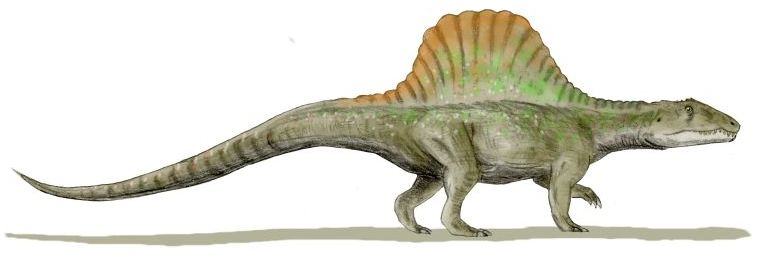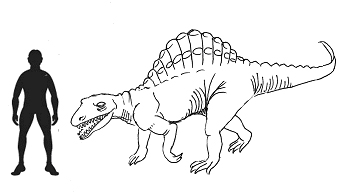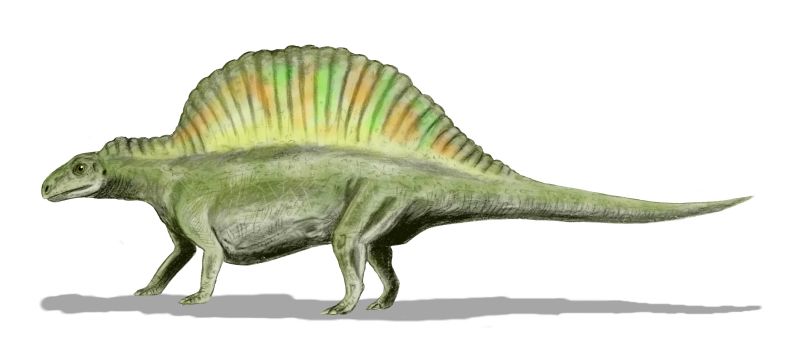[Recent Entries][Archive][Friends][User Info]
March 1st, 2012
| March 1st, 2012 | |
|---|---|
| 06:45 pm [industrialterro] [Link] |
Arizonasaurus Arizonasaurus was a ctenosauriscid archosaur from the Middle Triassic (240 million years ago). Arizonasaurus is found in the Middle Triassic Moenkopi Formation of northern Arizona. A fairly complete skeleton was found in 2002 by Sterling Nesbitt. The taxon has a large sailback formed by elongate neural spines of the vertebrae. The type species, Arizonasaurus babbitti, was named by Samuel Paul Welles in 1947. It superficially resembles the sail-backed synapsids Dimetrodon and Edaphosaurus, which lived millions of years earlier during the Late Pennsylvanian and Permian. Ctenosauriscidae is an extinct family of pseudosuchian archosaurs within the clade Poposauroidea. Ctenosauriscids existed in Africa, Asia, Europe and North America during the Early Triassic to the Middle Triassic period (latest Olenekian to Anisian stages). All species had large "sails" on their backs. Ctenosauriscids are among the earliest archosaurs and represent the first global radiation of the group. Poposauroidea is a clade of rauisuchians. It includes poposaurids, shuvosaurids, and ctenosauriscids, but excludes the large predatory quadrupedal rauisuchians such as rauisuchids and prestosuchids. Although it was first formally defined in 2007, the term has been used for many years. The group has been referred to as Poposauridae by some authors, although this name is often used more narrowly to refer to the family that includes Poposaurus and its close relatives. Rauisuchia is a group of predatory and mostly large (often 4 to 6 meters) Triassic archosaurs. As a clade, Rauisuchia includes these Triassic forms and all crocodylomorphs, which are descendants of Triassic rauisuchians. The group in its traditional sense is paraphyletic, because it does not include crocodylomorph descendants. To designate it as an informal group in scientific literature, the name in its traditional sense is often enclosed in quotation marks. Both José Bonaparte and Michael Benton argue that rauisuchians such as Saurosuchus developed an erect stance independently of, and different from that of dinosaurs, by means of having the femur vertical and angling the acetabulum ventrally, rather than having an angled neck or curve in the femur. This has been referred to as the pillar-erect posture. The erect gait indicates that these animals were clearly active, agile predators, with locomotor superiority over the kannemeyeriid dicynodonts and abundant rhynchosaurs on which they fed. They were successful animals, the largest with skulls up to a meter or more in length, and continued right until the end of the Triassic, when, along with many other large archosaurs, they were killed off by the end Triassic extinction event. With their demise, theropod dinosaurs were able to emerge as the sole large terrestrial predators. Meat-eating dinosaur footprints suddenly increase in size at the start of the Jurassic, when rauisuchians are absent.
Размеры тела в сравнении с человеком:
Tags: Вымершие рептилии, Триас, архозавроморфы, архозавры, диапсиды, круротарзы, ктенозаврисциды, попозавройды, равизухии |
| Time | Event |
| 07:24 pm [industrialterro] [Link] |
Ctenosauriscus Ctenosauriscus is an extinct genus of sail-backed poposauroid archosaur from Early Triassic deposits of Lower Saxony in northern Germany. It gives its name to the family Ctenosauriscidae, which includes other sail-backed poposauroids such as Arizonasaurus. Fossils have been found in latest Olenekian deposits around 247.5-247.2 million years old, making it one of the first known archosaurs. The most prominent feature of Ctenosauriscus is its sail-like back, formed from elongated neural spines of the dorsal and cervical vertebrae. These spines curve slightly forward at the front of the sail and slightly backward at the back of the sail. Although other poposauroids like Lotosaurus and the ctenosauriscids Hypselorhachis and Xilousuchus also have elongated spines, the sail of Ctenosauriscus is one of the largest in the group. Among ctenosauriscids, Ctenosauriscus is most similar to Arizonasaurus from the Middle Triassic of the southwestern United States. Both of these ctenosauriscids have elongated vertebrae spines up to 12 times the height of the bodies of the vertebrae. The ends of the spines are wider in Ctenosauriscus, and Ctenosauriscus also has larger projections on the centra of the dorsal vertebrae. Hypselorhachis also has neural spines that are widened at the end, but they are shorter than those of Ctenosauriscus. Lotosaurus from the Middle Triassic of China also has elongate spines, but they are straighter, broader, and much shorter than those of Ctenosauriscus. A 1998 study proposed that Ctenosauriscus was bipedal and that its elongated neural spines served to absorb the forces exerted from walking on two legs. Although limb bones are unknown, the study found that forces on the tips of the spines were focused on a point below the spinal column, hypothesized to be the knee joint. In the 2011 redescription of Ctenosauriscus, the authors rejected this idea because for forces on the spine to meet at the knee joint, muscles would have to form a direct connection between the knee and the back. Forces exerted from movement travel from the hind legs to the hip and sacral vertebrae, not the dorsal vertebrae. The sail of Ctenosauriscus would also have shifted its center of weight toward the front of the body, making bipedal locomotion difficult or impossible.
Tags: Вымершие рептилии, Триас, архозавроморфы, архозавры, диапсиды, круротарзы, ктенозаврисциды, попозавройды, равизухии |
| Time | Event |
| 07:38 pm [industrialterro] [Link] |
Xilousuchus Xilousuchus is an extinct genus of poposauroid from lower Triassic (Olenekian stage) deposits of Fugu County of northeastern Shanxi Province, China. It is known from the holotype, IVPP V 6026, a single well-preserved partial skeleton including the skull. It was found from the Heshanggou Formation of the Ordos Basin, Hazhen commune. It was first named by Xiao-Chun Wu in 1981 and the type species is Xilousuchus sapingensis. Wu (1981) referred Xilousuchus to the Proterosuchia. Gower and Sennikov (1996) found it to be an erythrosuchian based strictly on the braincase. A more detailed re-description of the genus was provided by Nesbitt et al. (2010) and found poposauroid affinities. In his massive revision of archosaurs which included a large cladistic analysis, Sterling J. Nesbitt (2011) found Xilousuchus to be a poposauroid which is most closely related to Arizonasaurus. Xilousuchus is the oldest archosaur to date, although Ctenosauriscus and Vytshegdosuchus might be even older by less than one million year. Since Xilousuchus is a suchian archosaur, its early age suggests that most of the major groups of archosaurs (ornithodirans, ornithosuchids, aetosaurs, and paracrocodylomorphs) developed by the Early Triassic, soon after the appearance of the first archosaur. Ископаемое существо, найденное в Китае в 1970-х и считавшееся дальним родственником птиц и крокодилов, оказалось членом генеалогического древа крокодилов на том этапе, когда они уже отделились от птиц. Единственный образец Xilousuchus sapingensis теперь классифицируется как архозавр. Стерлинг Несбитт из Университета штата Вашингтон (США) датирует вид ранним триасом (252–247 млн лет назад). Это значит, что он жил всего несколько геологических минут спустя после крупнейшего массового вымирания в истории Земли, случившегося в конце пермского периода (погибли 95% морских и 70% сухопутных видов). «В поисках происхождения архозавров мы всё ближе и ближе к границе перми и триаса», — отмечает специалист. Исследование может обострить дискуссию о том, существовали ли архозавры до биологической катастрофы или же в конце перми жили их предшественники, а сами архозавры стали продуктом восстановления фауны после вымирания. X. sapingensis — череп и 10 позвонков — был найден в формировании Хэшангоу в северном Китае в отложениях, которые датируются не только началом и серединой триаса (252–230 млн лет назад), но и периодом до массового вымирания. Ископаемое первоначально классифицировали как archosauriform, то есть родственник архозавров, а не истинный архозавр, но это было до открытия более полных образцов ранних архозавров из других частей триасового периода. Исследователи заново изучили кости образца, сравнив их с останками ближайших родственников архозавров, и нашли серьёзные отличия от всех archosauriformes. В частности кости на кончике челюсти, где должны располагаться зубы, оказались загнуты вниз не так сильно, как было впервые описано в 1980-х годах. Обнаружено также, что нервные шипы шеи формировали переднюю часть паруса так же, как у другого древнего архозавра под названием Arizonasaurus. Главный вывод заключается в том, что предки птиц и крокодилов разделились раньше, чем принято было ранее считать. Результаты исследования опубликованы в журнале Earth and Environmental Science Transactions. </index>
Tags: Вымершие рептилии, Триас, архозавроморфы, архозавры, диапсиды, круротарзы, ктенозаврисциды, попозавройды, равизухии |
| Previous Day | 2012/03/01 [Archive] |
Next Day |









